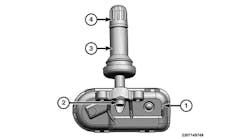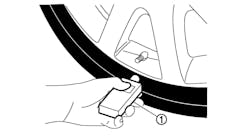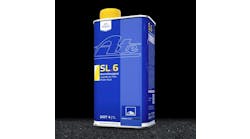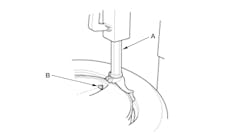Real World Experience with R1234yf: The New Refrigerant is Finally Here; Are You Ready?
In 2014, Fiat Chrysler began filling the air conditioning systems on almost all of its models with R1234yf refrigerant. That same year, General Motors (GM) began using it in the Cadillac XTS. Since then, GM has been gradually switching over its entire line of vehicles to R1234yf, and Ford has also begun using it, too.
Much has been written about what to expect when the industry changes over to the new refrigerant, but up until now it was all speculation. Shops that do A/C work for collision repair have been working with R1234yf for three years, and with some 2014 models just starting to come out of warranty now, some independent tire dealers and technicians are finally gaining real world experience with the new refrigerant and the new tools and service techniques. Here is some of what they’ve learned so far.System hardware
Air conditioning systems filled with R1234yf are almost identical to those using R134a, but there are a few important differences. First of all, there is one additional component: an inline heat exchanger (IHX) that has two concentric chambers. Liquid refrigerant from the condenser flows through the inside chamber, and the outside chamber surrounds it with vapor flowing out of the evaporator on its way back to the compressor. The still-cool vapor absorbs heat out of the liquid refrigerant, “sub cooling” it below condensation temperature to improve overall system efficiency.
There are two basic types of IHX. On A/C systems with an orifice tube, the IHX is generally (but not always) built into the accumulator. On an expansion valve system, it’s more likely to be a separate part, a tube-within-a-tube that has a pair of inlet/outlet fittings on each end. There are no moving parts to wear out, so unless it’s damaged there’s no need to replace one. Still, it’s important to know it’s there and what it does.
Another difference involves the new service ports and caps. The service ports are designed to make it impossible to connect service equipment that’s made for systems using other refrigerants. Of course, adapters are available and some shops may actually find a legitimate reason to use them, but we’ll discuss that later.
Service ports have been identified as a source of refrigerant leakage and air contamination. If the vehicle sits long enough at a low-enough ambient temperature, most of the refrigerant will condense to a liquid and system pressure can fall below atmospheric pressure. This will allow ambient pressure to unseat the service port valve and let air into the system, contaminating the system with air. Of course this will never happen in Florida, but sometimes it does happen up North, so the new service port caps have an O-ring to seal the cap to the port.The O-ring not only keeps air out, it also keeps the port clean inside, protecting the valve from debris that can cause a slow leak by preventing it from seating properly after service. The cap is supposed to be tethered to the port so it doesn’t get lost when removed, but some car models have been sold without tethered caps. New caps with a tether are available as replacement parts.
Finally, the new A/C systems are fitted with a redesigned evaporator that’s stronger and less likely to leak. That doesn’t mean you shouldn’t check it for leaks, but if you replace one, make sure the package or tag on the new part indicates that it meets the new SAE J2842 standard.
Refrigerant flammability
Some service port caps have an icon on the top indicating the refrigerant is flammable. The flammability issue has attracted a lot of attention, prompting the industry to conduct some serious third-party testing. The bottom line is this: The refrigerant will burn, but it takes a lot of heat to ignite it and it burns slowly. Almost every other fluid under the hood will light more easily and burn hotter than R1234yf, so the industry has determined that with proper A/C system design, it does not increase the chances of fire in the vehicle.
Working with the new refrigerant requires a bit more caution. The new service machines are built with ventilation fans and ignition-proof solenoids and switches. If you’re going to service the system without using one of these new machines, take the same precautions you would when working with a fuel system.Handling and storage require a bit more caution, too. The refrigerant is available in easy-to-manage 10-pound containers. Even though it’s officially classified as “mildly flammable,” warning labels on the container indicate the contents to be “highly flammable” because the gas is under pressure. Therefore, requirements for safe handling and storage of R1234yf containers are the same as those for other compressed flammable gasses.
- Refrigerant containers should not be exposed to direct sunlight or to temperatures greater than 125 degrees Fahrenheit (52 degrees Celsius).
- Containers should be stored in a cool, ventilated area away from any possible ignition sources.
- Containers should be strapped into place and protected from physical damage, moisture and corrosive liquids or gases.
Service equipment
You may already know there are some new A/C service machines on the market designed for use with R1234yf. Here’s a quick summary.
The newest recovery/recycle/recharge (RRR) machines are designed to SAE Standard J2843, and they have fittings on the hoses that will only connect to vehicles that use R1234yf. The SAE standard describes the major features of the machine:
- It will recover 95% of the refrigerant in the system.
- It will recharge the system to within 1/2 ounce of specification.
- After recovering 150 pounds of refrigerant, it will not run again until the onboard filter/drier is changed.
- It will have a built-in refrigerant identifier or a USB port to connect an identifier.
- It will not allow recovery of contaminated refrigerant.
- It will not recharge the system if it detects a leak.
- It has ventilation fans and non-sparking switches, motors, relays, etc.
The recovery and recharge processes are highly automated and/or fully automatic, but the tech may be prompted to run some tests before the machine moves on to the next step. Some of the new machines used by OEM dealerships have software that is specific to those brands, so they might not work on different brand vehicles. However, the machines sold to the aftermarket are universal.
New machines are available that are designed to the same SAE standard but equipped with fittings for vehicles that use R134a. New hoses and fittings can be installed to reconfigure it for servicing R1234yf systems, but it’s not a “convertible.” Once reconfigured, it can’t be converted back to the old refrigerant. This means that a shop needing a new R134a machine now can buy one knowing that it can be converted when they have enough business that requires R1234yf service.Since the new machines will not recover contaminated refrigerant, your shop will need some kind of recovery-only machine. Because R1234yf is mildly flammable, shops should not just use an old R134a machine with fitting adapters; it must be specifically designed to SAE Standard J2851, which applies to recovery-only machines. Some machines will simply be described as “spark free” and that’s OK, but the holding cylinder must also be rated for flammable gases.
Service techniques
Once the machine is connected and the data has been entered, all the tech has to do is follow the prompts on the screen. The machine will identify the refrigerant and then recover the refrigerant (and oil) if it’s at least 98% pure. At this point the procedure can be interrupted if the tech intends to remove parts.
Before charging the system, the machine will pull a vacuum and watch for vacuum decay that indicates a leak. If the system passes the vacuum leak test, the machine will install 15% of the total refrigerant charge into the system and prompt the tech to run an evaporator leak test. This consists of turning the blower on low, selecting the floor vents and inserting a leak detector probe into the center floor duct. When the tech confirms there is no leak and pushes the “continue” button, the machine will automatically recharge the system with the correct amount of refrigerant and oil. Finally, it will print a service report that includes the amount of refrigerant recovered and recharged into the system.
If the system is already empty, old-school recharging methods still work because the basics are still the same. With the proper gauges, good scales and a vacuum pump, an experienced A/C tech can recharge the system and make it blow cold air. However, for professionals getting paid to do the job, this is not legal. A shop can be fined for doing A/C service without the proper equipment or service reports. Besides, R1234yf refrigerant is so expensive that even a minor leak or accidental loss during service can remove all the profit from the job. The recovery/recycle machines are specifically designed to prevent this.Contaminated refrigerant
If the refrigerant in the system is less than 98% pure R1234yf, the service machine will not recover it. At this point you will need to connect a recovery-only machine and collect the refrigerant for disposal. Since the refrigerant is flammable, using the proper equipment that meets SAE J2851 standards is important, but there’s also another reason to use one of these machines.
At this point we haven’t found any real-world examples of contamination to report. However, just as with R134a systems, the DIYer will cause problems. Consumer-size cans of R1234yf refrigerant will be available later this year, but it will cost about five times more than R134a. Some will contain the same sealers, dyes and lubricant additives found in consumer-size cans of other refrigerants. While there may be situations when these additives are appropriate, they are not recommended or approved by the OEM, and they may cause the machine to abort the service procedure.
Because there is no plan to retrofit existing A/C systems to use R1234yf, production of R134a will continue indefinitely for service. Because fitting adapters are available to connect R134a service hoses to R1234yf systems, some consumers or even technicians might decide to fill a system with other refrigerants that costs less than R1234yf. While this is legal and most of the alternative refrigerants will work well enough, some are known to be highly flammable, easy to ignite, and produce extremely toxic gases when burned.It’s still early, but because the refrigerant is so expensive and the equipment needed to service the system is so specialized, we think improper service techniques (pro and DIY) will make refrigerant contamination a much bigger issue that it has been in the past. So as your shop prepares to service cars with R1234yf, make sure the equipment list includes at least one refrigerant identifier and a recovery-only machine. Otherwise, experienced A/C techs have found nothing different when it comes to servicing these systems, and that’s exactly what the manufacturers intended. ■
Jacques Gordon has worked in the automotive industry for 40 years as a service technician, lab technician, trainer and technical writer. His began his writing career writing service manuals at Chilton Book Co. He currently holds ASE Master Technician and L1 certifications and has participated in ASE test writing workshops.




